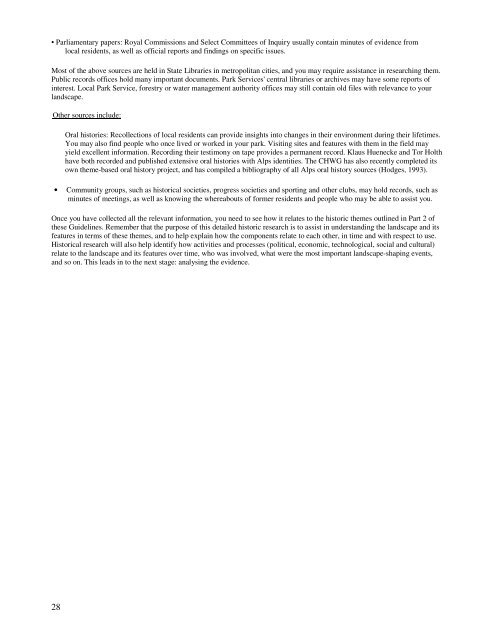Cultural Landscape Management - Australian Alps National Parks
Cultural Landscape Management - Australian Alps National Parks
Cultural Landscape Management - Australian Alps National Parks
You also want an ePaper? Increase the reach of your titles
YUMPU automatically turns print PDFs into web optimized ePapers that Google loves.
• Parliamentary papers: Royal Commissions and Select Committees of Inquiry usually contain minutes of evidence fromlocal residents, as well as official reports and findings on specific issues.Most of the above sources are held in State Libraries in metropolitan cities, and you may require assistance in researching them.Public records offices hold many important documents. Park Services' central libraries or archives may have some reports ofinterest. Local Park Service, forestry or water management authority offices may still contain old files with relevance to yourlandscape.Other sources include:Oral histories: Recollections of local residents can provide insights into changes in their environment during their lifetimes.You may also find people who once lived or worked in your park. Visiting sites and features with them in the field mayyield excellent information. Recording their testimony on tape provides a permanent record. Klaus Huenecke and Tor Holthhave both recorded and published extensive oral histories with <strong>Alps</strong> identities. The CHWG has also recently completed itsown theme-based oral history project, and has compiled a bibliography of all <strong>Alps</strong> oral history sources (Hodges, 1993).• Community groups, such as historical societies, progress societies and sporting and other clubs, may hold records, such asminutes of meetings, as well as knowing the whereabouts of former residents and people who may be able to assist you.Once you have collected all the relevant information, you need to see how it relates to the historic themes outlined in Part 2 ofthese Guidelines. Remember that the purpose of this detailed historic research is to assist in understanding the landscape and itsfeatures in terms of these themes, and to help explain how the components relate to each other, in time and with respect to use.Historical research will also help identify how activities and processes (political, economic, technological, social and cultural)relate to the landscape and its features over time, who was involved, what were the most important landscape-shaping events,and so on. This leads in to the next stage: analysing the evidence.28
















